Hola amigos, les doy una cálida bienvenida una vez más a mi espacio de salud física y me da mucha alegría poder compartir con todos ustedes como siempre diferentes rutinas de ejercicios fisioterapéuticos o formas de aliviar dolores en nuestro cuerpo causado por distintas enfermedades. El día de hoy vamos hacer unos ejercicios para aliviar el dolor causado por escoliosis en el adulto mayor, pero primero voy hablarles un poco sobre la escoliosis.
La escoliosis degenerativa es una desviación de la columna resultado de la regeneración progresiva de los elementos de una columna que antes se encontraba recta, tiene una prevalencia del 6 al 68% en la población adulta mayor, existe una clasificación de la escoliosis en el adulto mayor y se divide en 3:
1- Degenerativa primaria: acá existen deformidades vertebrales mínimas como lo son las micro fracturas.
2- Deformidad idiopática progresiva: aparece en la niñez o en la adolescencia, pero se vuelve sintomática hasta la vida adulta.
3- Degenerativa secundaria: esta se refiere a que aparece secundaria a alguna discrepancia entre las piernas, alguna cadera patológica o incluso algunas enfermedades metabólicas como es la osteoporosis.
En el 90% de los pacientes la escoliosis se presenta con dolor y se considera que este dolor es secundario a una fatiga muscular por sobrecarga. También se puede presentar déficit neurológico causando alteraciones de la marcha, atrofia de los músculos de la pantorrilla o del muslo y alteraciones en la sensibilidad en las piernas. El diagnostico se basa en una exploración física completa en radiografías y en ocasiones la tomografía y resonancia magnética pueden proporcionar mayor información sobre el déficit neurológico, además una evaluación de la función pulmonar puede ser de gran utilidad. El tratamiento conservador se indica en aquellas personas que no presentan un déficit neurológico o dolor severo, por lo que este tratamiento conservador incluye los fármacos como los antiinflamatorios no esteroideos, los narcóticos e incluso los relajantes musculares, la terapia física, el ejercicio y yoga. Las cirugías se indica en aquellas personas en las que el dolor no responda a estos métodos conservadores por más de 6 meses y también en aquellas personas en la que la afección de la calidad de vida es muy severa y cuando también existe déficit neurológico.
A continuación, les mostrare 5 ejercicios que les ayudaran aliviar el dolor causado por la escoliosis:
Hello friends, I give you a warm welcome once again to my physical health space and it gives me great joy to share with all of you as always different routines of physiotherapeutic exercises or ways to relieve pain in our body caused by various diseases. Today we are going to do some exercises to relieve pain caused by scoliosis in the elderly, but first I am going to talk a little about scoliosis.
Degenerative scoliosis is a deviation of the spine resulting from the progressive regeneration of the elements of a spine that was previously straight, has a prevalence of 6 to 68% in the older adult population, there is a classification of scoliosis in the elderly and is divided into 3:
1- Primary degenerative: here there are minimal vertebral deformities such as micro fractures.
2- Progressive idiopathic deformity: it appears in childhood or adolescence, but becomes symptomatic until adulthood.
3- Secondary degenerative: this refers to the fact that it appears secondary to a discrepancy between the legs, a pathological hip or even some metabolic diseases such as osteoporosis.In 90% of patients scoliosis presents with pain and this pain is considered to be secondary to muscle fatigue due to overload. Neurological deficits may also be present causing gait disturbances, atrophy of the calf or thigh muscles and altered sensation in the legs. The diagnosis is based on a complete physical examination in radiographs and sometimes CT and MRI can provide more information about the neurological deficit, in addition an evaluation of pulmonary function can be very useful. Conservative treatment is indicated in those who do not present a neurological deficit or severe pain, so this conservative treatment includes drugs such as non-steroidal anti-inflammatory drugs, narcotics and even muscle relaxants, physical therapy, exercise and yoga. Surgeries are indicated in those people in whom the pain does not respond to these conservative methods for more than 6 months and also in those people in whom the affection of the quality of life is very severe and when there is also neurological deficit.
Here are 5 exercises that will help relieve the pain caused by scoliosis:
Ejercicio 1
Nos vamos a sentar en una silla estable con el respaldo de la silla al lado derecho con piernas a lo ancho de la cadera y pies bien apoyados en el piso, pasamos por el respaldo el brazo derecho (podemos colocar un cojín o una toalla) para evitar molestias en la axila he inclinamos nuestro torso al lado derecho, tomamos una inhalación profunda al tiempo que elevamos brazos izquierdo hacia el techo y si no hay molestias, pueden llevar su brazo un poco más a lado derecho, regresamos lento exhalando, realizaremos 5 repeticiones con brazo derecho y al culminar cambiamos nuestra silla que el respaldo quede de nuestro lado izquierdo y hacemos igualmente el ejercicio con brazo derecho, con este ejercicio le estamos dando flexibilidad a nuestra columna.
Exercise 1
We are going to sit on a stable chair with the back of the chair on the right side with legs hip-width apart and feet flat on the floor, we pass through the back the right arm (we can place a cushion or a towel) to avoid discomfort in the armpit and we lean our torso to the right side, we take a deep breath while we raise our left arm to the ceiling and if there is no discomfort, you can take your arm a little more to the right side, we return slowly exhaling, we will perform 5 repetitions with the right arm and at the end we will change our chair so that the back is on our right side and we will do the same exercise with the right arm, We will perform 5 repetitions with right arm and at the end we change our chair so that the backrest is on our left side and we do the same exercise with right arm, with this exercise we are giving flexibility to our spine.
Brazo izquierdo / Left arm

Brazo derecho / Right arm
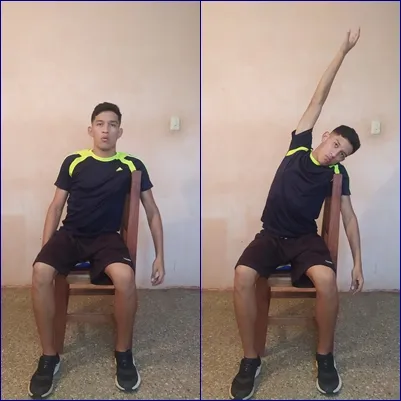
Ejercicio 2
Colocamos manos sobre el respaldo de la silla, damos un paso hacia atrás a que queden nuestros brazos bien estirados y nuestro torso formando un ángulo de 90° grados, vamos a inhalar profundo al tiempo que elevamos hacia el techo nuestro brazo derecho girando también el torso, exhalamos y regresamos a colocar manos sobre el respaldo, nuevamente inhalamos llevando mano hacia arriba y exhalamos al regresar llegando hacer 5 repeticiones, la rodilla se debe flexionar alternadamente mientras giran el torso (fíjense en la imagen), luego que culminemos con brazo derecho pasamos hacer el ejercicio con brazo izquierdo.
Exercise 2
We place our hands on the back of the chair, take a step backwards so that our arms are well stretched and our torso forming an angle of 90° degrees, we will inhale deeply while we raise our right arm towards the ceiling also turning our torso, exhale and return to place our hands on the back of the chair, again we inhale taking our hand upwards and exhale when returning to do 5 repetitions, the knee should be flexed alternately while turning the torso (look at the picture), after we finish with the right arm we do the exercise with the left arm.
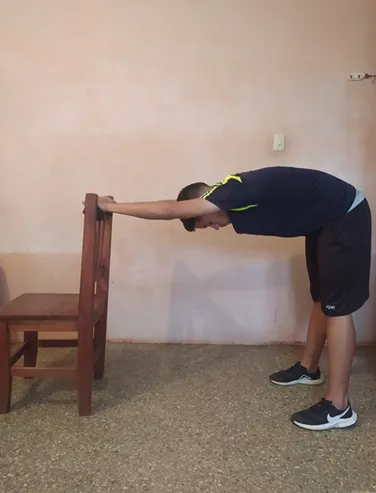
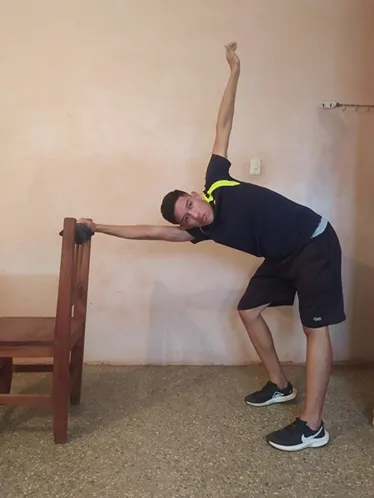
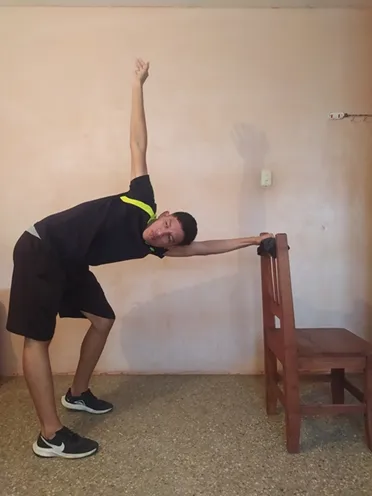
Ejercicio 3
Nos acostamos boca abajo en una cama o el suelo con codos pegados al cuerpo con piernas abiertas a lo ancho de la cadera, para este ejercicio necesitamos una pelo o botella pequeña y la colocamos bajo la mano derecha con palma abierta, tomamos una inhalación profunda y al exhalar vamos a rodar la pelota o botella hacia arriba estirando nuestro codo y regresamos a pegar codo a nuestro cuerpo al tiempo que inhalamos profundo, vamos a realizar 5 repeticiones con ambos brazos, con este ejercicio estamos dándole movimiento a nuestra musculatura dorsal.
Exercise 3
We lie face down on a bed or the floor with elbows glued to the body with legs open to hip width, for this exercise we need a hair or small bottle and place it under the right hand with open palm, we take a deep breath and exhale we will roll the ball or bottle upward stretching our elbow and return to stick elbow to our body while inhaling deep, we will perform 5 repetitions with both arms, with this exercise we are giving movement to our dorsal musculature.
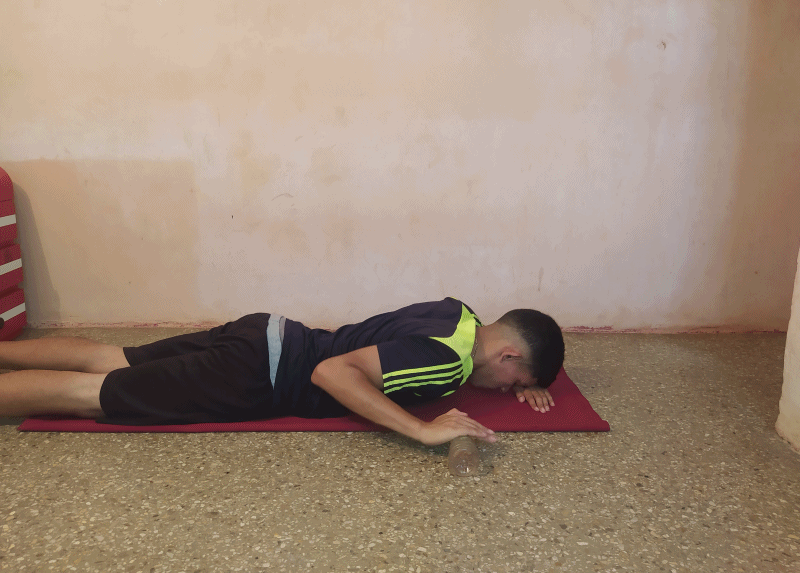
Ejercicio 4
Acostados boca abajo vamos a tener codos abiertos a 90° grados, ponemos una almohada alta bajo nuestro abdomen, tomamos una inhalación profunda en esta posición y al exhalar vamos a tratar de elevar nuestro torso, regresaos lento inhalando profundo por la nariz y si se les complica realizar este ejercicio pueden apoyarse con los brazos para elevar el torso, realizaremos 5 repeticiones de este ejercicio, además de dar flexibilidad también estamos trabajando la fuerza en nuestros músculos de la espalda para disminuir el dolor.
Exercise 4
Lying face down we will have elbows open at 90 ° degrees, put a high pillow under our abdomen, we take a deep breath in this position and exhaling we will try to raise our torso, return slowly inhaling deeply through the nose and if it is difficult to perform this exercise can be supported with the arms to raise the torso, we will perform 5 repetitions of this exercise, in addition to giving flexibility we are also working the strength in our back muscles to reduce pain.
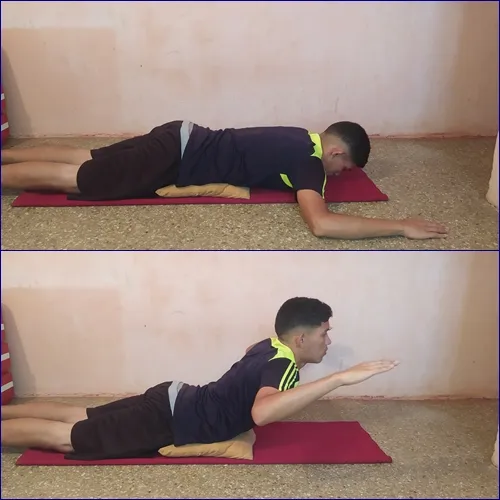
Ejercicio 5
Para nuestro último ejercicio nos acostamos boca arriba con piernas dobladas a lo ancho de nuestra cadera y pies bien apoyados en el suelo, pierna izquierda se quedará bien apoyada mientras trabajamos con la derecha, tomamos una inhalación en esta posición y al exhalar abrimos la cadera derecha y estiramos rodilla, regresamos pierna tomando aire por la nariz, realizamos 5 repeticiones con pierna derecha y al culminar cambiamos a pierna izquierda.
Exercise 5
For our last exercise we lie on our back with legs bent at the width of our hips and feet well supported on the floor, left leg will remain well supported while we work with the right, we take an inhalation in this position and exhaling we open the right hip and stretch the knee, we return leg taking air through the nose, we perform 5 repetitions with right leg and at the end we change to left leg.
Pierna derecha / Right leg
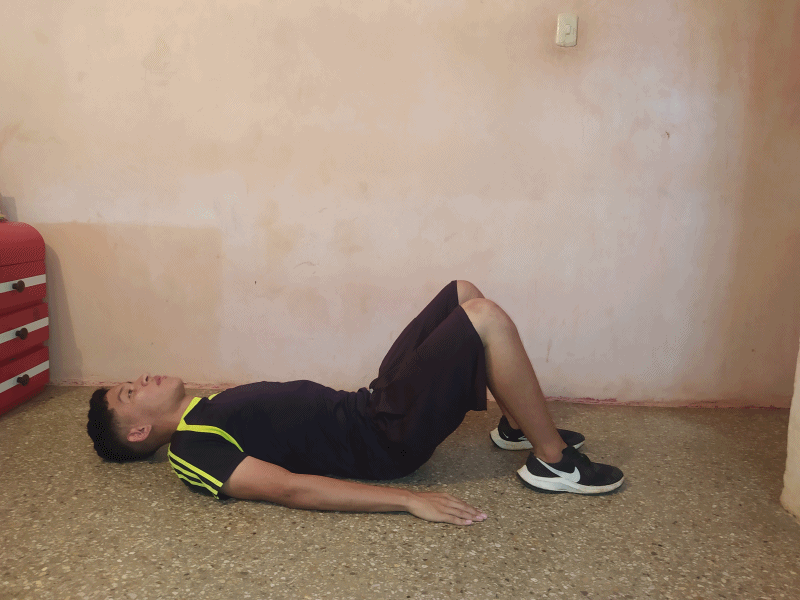
Pierna izquierda / Left leg
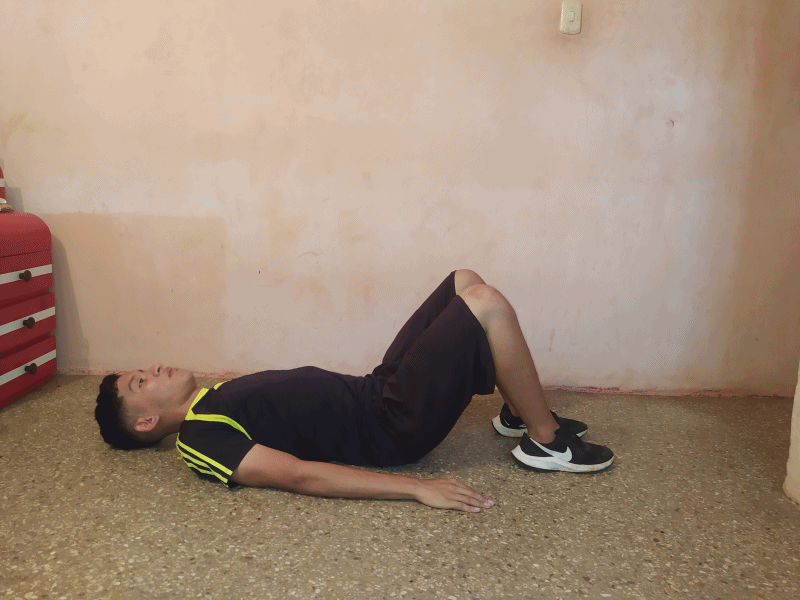
Bueno espero les guste y puedan poner en practica cada uno de estos ejercicios fisioterapéuticos no antes de acudir primero a su médico, hasta una próxima oportunidad cuídense.
Well I hope you like it and can put into practice each of these physiotherapeutic exercises not before going to your doctor first, until next time take care of yourself.
Si les gusto déjenme saber en los comentarios como les fue con cada uno de estos ejercicios.
Gracias por leerme.
La publicación y fotografías son de mi autoría.
Fotos tomadas por: @alexam99
Teléfono: Xiaomi Redmi Note 8
Traducción: deepl
Collage: fotor
Gif: Photoscape for Windows photoscape
If you like it, let me know in the comments how you did with each of these exercises.
Thanks for reading.
The publication and photos are my authorship.
Photos taken by: @alexam99
Phone: Xiaomi Redmi Note 8
Translation: deepl
Collage: fotor
Gif: Photoscape for Windows photoscape